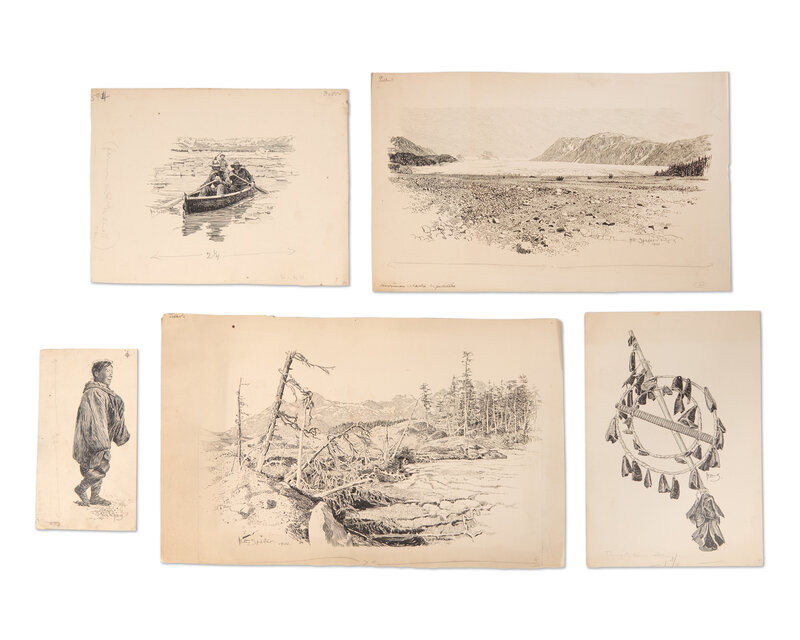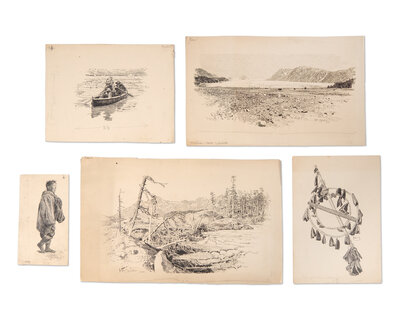[Travel & Exploration] Spader, William Edgar. Collection of 62 Original Drawings Illustrating the Harriman Alaska Expedition
Sale 2101 - Books and Manuscripts
Sep 10, 2024
10:00AM ET
Live / Philadelphia
Own a similar item?
Estimate
$10,000 -
15,000
Lot Description
[Travel & Exploration] Spader, William Edgar. Collection of 62 Original Drawings Illustrating the Harriman Alaska Expedition
Likely New York, ca. 1900-1905. Group of 62 ink line drawings on thick card stock, each signed or initialed by William Edgar Spader. Sizes vary, between 4 1/4 x 8 in. (114 x 203 mm) and 17 1/2 x 10 3/4 in. (444 x 273 mm). Scattered light wear along edges; scattered soiling; some scattered surface wear. In blue cloth fall-down-back box.
A remarkable archive from the Harriman Alaska Expedition, comprising 62 original drawings by William E. Spader, one of the principal artists hired to create illustrations for Edward Harriman's monumental fourteen-volume work The Harriman Alaska Series. Published throughout the first decade-and-a-half of the 20th century, this important collection documents one of the great scientific expeditions of the late 19th century.
Edward H. Harriman was a wealthy railroad magnate, one of the original robber barons of lore, who greatly desired to hunt bear in Alaska. Never one to do anything small, he decided not only to travel to Alaska to hunt bear on Kodiak Island, but to finance a major scientific expedition to Alaska along the way. The Harriman Expedition comprised an elite roster of scientists, artists, photographers, and naturalists whose goal was to explore and document the Alaskan coastline. For almost two months, in June and July 1899, the S.S. George W. Wilder steamed up the coast from Seattle to Siberia while various experts, including John Muir, Edward Curtis, and other botanists, biologists, geologists, artists and photographers recorded what they encountered along the way. The greatest benefit of the expedition turned out to be the sizeable published record of the journey, which Harriman financed himself. The fourteen-volume Harriman Alaska Series was published by Doubleday beginning in 1901, and remains a landmark of Arctic exploration.
William Edgar Spader was a Brooklyn-born illustrator, whose work appears in much of Harriman's Alaska Series. His drawings here show landscapes, numerous views of glaciers, seal hunting, camp scenes, several scenes featuring canoeing or kayaking, one illustration of death head carvings, and much more. Some of the illustrations are captioned in pencil on the reverse, identifying specific views of Davidson Glacier, Hinchinbrook Island, Spruce Island, Hanging Valley, Grewingk Glacier, Charpentier Glacier, Plover Bay, Reid Glacier, Yale Glacier, Chilkoot Lake, Russell Fiord, College Fiord, the head of Lynn Canal, a view upland near Walker Bay, the tundra near Port Clarence, a view showing the caves in Barry Glacier, a landscape showing the ridged surface of Columbia Glacier, a large landscape showing the moraine of Columbia Glacier, a landscape of the hills near Brady Glacier, a large scene of an overturned forest near the La Perouse Glacier, an indoor view of a church at Metlakahtla, and a distant view of St. Paul Village, among others. A few examples show production notes, including size notations and penciled frame lines.
Spader's dozens of illustrations for Harriman's published work are well-executed black-and-white line drawings after photographs from the expedition by the likes of Grove Karl Gilbert, C. Hart Merriam, A.K. Fisher, W.B. Devereaux, and others. Numerous examples of Spader's original artwork was used to illustrate volume one of the Harriman Alaska series, starting with John Burroughs' introductory essay, "Narrative of the Expedition." One illustration is captioned on the reverse, "Little Auklets Pribilof Islands, Bering Sea For Burroughs' Article." It is marked in pencil "Vol. 1, Pg. 98," where it appears in the printed work. Another illustration captioned on the verso, in pencil, "Church at Metlakahtla" is captioned in the published work as "Interior of Church Made by Indians at Metlakahtla" on page 25 of Burroughs' work. An illustration by Spader of an irrigating water wheel can be seen on page 13 of Burroughs' essay, another of a canoe in drift ice in Yakutat Bay is found on page 95, and yet another of "Yakutat Indians Paddling" appears on page 60. More Spader illustrations can be found in John Muir's contribution in volume one of the Harriman Alaska series; two views of Davidson Glacier appear on page 121 of volume one with both of the original illustrations having pencil notations on the verso identifying them as "Davidson Glacier...Muir or After." Yet more Spader illustrations appear in the final essay in volume one of the published work, George Bird Grinnell's "The Natives of the Alaska Coast Region," namely: The Tlinkit Dance Rattle (p. 139), a Tlinkit canoe of southeast Alaska (p. 140), a Yakutat sealing canoe (p. 162), the aforementioned death's head carving (p. 165), an "Eskimo Summer House and Fireplace, Plover Bay, Siberia" (p. 171), an Eskimo man and woman at Plover Bay (p. 175), and an Eskimo umiak (p. 179).
Numerous illustrations of glaciers included here are featured in Gilbert's Glaciers and Glaciation (volume three of the series). An examination of the text yields no fewer than thirteen examples of Spader's artwork featured in the published version of Gilbert's work, highlights of which include large drawings of Barry Glacier, College Fiord, Reid Glacier from the Northeast, the ice cliff of Hubbard Glacier hovering over Disenchantment Bay, and the moraine of the Columbia Glacier.
Three of Spader's drawings present here illustrate a poem called "The Song of the Innuit" by William H. Dall, which was printed at the end of the second volume of The Harriman Alaska Series. Dr. Dall was a paleontologist for the U.S. Geological Survey, Honorary Curator of Mollusks at the U.S. National Museum, and also a member of the scientific party for the Harriman expedition. One illustration titled "Black Iceberg" is marked on the reverse, "Harriman Alaska Expd. Return original & proof to C. Hart Merriam Washington D.C." Clinton Hart Merriam was the head of the Division of Economic Ornithology and Mammalogy at the United States Department of Agriculture, one of the founders of the National Geographic Society, and most importantly here, the organizer of the scientific party for the Harriman Alaska Expedition. Merriam's treatise on the Bogoslof volcano in volume two of Harriman's Alaska yields yet another Spader illustration utilized in the published work, namely his drawing of Murre's eggs on p. 330.
A wonderful archive of Spader's work.
This lot is located in Philadelphia.
Condition Report
Auction Specialist

